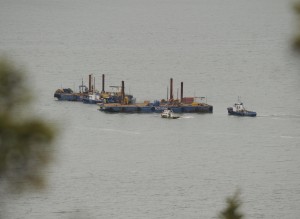If it's built, the Energy East pipeline would cross 828 bodies of water and 69 municipalities in Quebec, a document obtained by Radio-Canada shows.
The document, included in a letter sent on June 11, 2015 from TransCanada to the Union of Quebec Municipalities, details each type of body of water that would be crossed by the proposed 4,600-kilometre pipeline.
Most of the channels are narrow — they include 46 "perennial" streams, 395 "intermittent" streams and 233 "permanent small watercourses".
However, the pipeline would also cross 94 "medium permanent" rivers, 28 "large permanent" rivers, 28 beaver ponds and four ponds.
Categories of water bodies
- Ephemeral watercourse: Flows after heavy rains and melting snow in the spring and is characterized by a poorly-defined river bed and banks.
- Intermittent watercourse: Flows continuously for several weeks or months before drying out and is characterized by a well-defined river bed and banks.
- Small permanent watercourse: Narrower than five meters.
- Medium permanent watercourse: Has a width between five and 20 meters.
- Large permanent watercourse: Wider than 20 meters.
- Beaver pond: Large expansion of a stream created by a beaver dam.
- Pond: Small natural lake or one created on agricultural land.
Initially, the pipeline project was only expected to cross 641 bodies of water in the province, including 30 major ones.
But in December, École Polytechnique researchers said the soil along the banks of several rivers are too unstable to support a pipeline. Potential landslides could lead to flooding and the pollution of nearby waterways, the researchers said.
Among the rivers at risk were the Ottawa River, Mille-Îles, St. Maurice, Sainte-Anne and Jacques-Cartier rivers.
Municipalities crossed by the pipeline
In the same letter, TransCanada also lists the 69 Quebec municipalities that the pipeline would cross. Overall, the pipeline would run through 688 kilometres of municipal land.
The municipalities of Lévis (52.5 km), Mirabel (36.7 km) and Dégelis (32.8 km) would have the longest stretches.
*The original plans included a terminal in Cacouna, which has since been removed from the project.
TransCanada also stated in June 2015 that had mapped out 85 per cent of the pipeline route in Quebec.
Here's a break down of the type of terrain the pipeline would cross in the province.
- Forests: 51.8 per cent of the pipeline's span in Quebec.
- Agricultural land: 33.2 per cent.
- Wetlands: 13 per cent.
- Commercial, industrial and residential zones: 2 per cent.
Original Article
Source: huffingtonpost.ca/
Author: CBC
The document, included in a letter sent on June 11, 2015 from TransCanada to the Union of Quebec Municipalities, details each type of body of water that would be crossed by the proposed 4,600-kilometre pipeline.
Most of the channels are narrow — they include 46 "perennial" streams, 395 "intermittent" streams and 233 "permanent small watercourses".
However, the pipeline would also cross 94 "medium permanent" rivers, 28 "large permanent" rivers, 28 beaver ponds and four ponds.
Categories of water bodies
- Ephemeral watercourse: Flows after heavy rains and melting snow in the spring and is characterized by a poorly-defined river bed and banks.
- Intermittent watercourse: Flows continuously for several weeks or months before drying out and is characterized by a well-defined river bed and banks.
- Small permanent watercourse: Narrower than five meters.
- Medium permanent watercourse: Has a width between five and 20 meters.
- Large permanent watercourse: Wider than 20 meters.
- Beaver pond: Large expansion of a stream created by a beaver dam.
- Pond: Small natural lake or one created on agricultural land.
Initially, the pipeline project was only expected to cross 641 bodies of water in the province, including 30 major ones.
But in December, École Polytechnique researchers said the soil along the banks of several rivers are too unstable to support a pipeline. Potential landslides could lead to flooding and the pollution of nearby waterways, the researchers said.
Among the rivers at risk were the Ottawa River, Mille-Îles, St. Maurice, Sainte-Anne and Jacques-Cartier rivers.
Municipalities crossed by the pipeline
In the same letter, TransCanada also lists the 69 Quebec municipalities that the pipeline would cross. Overall, the pipeline would run through 688 kilometres of municipal land.
The municipalities of Lévis (52.5 km), Mirabel (36.7 km) and Dégelis (32.8 km) would have the longest stretches.
*The original plans included a terminal in Cacouna, which has since been removed from the project.
TransCanada also stated in June 2015 that had mapped out 85 per cent of the pipeline route in Quebec.
Here's a break down of the type of terrain the pipeline would cross in the province.
- Forests: 51.8 per cent of the pipeline's span in Quebec.
- Agricultural land: 33.2 per cent.
- Wetlands: 13 per cent.
- Commercial, industrial and residential zones: 2 per cent.
Original Article
Source: huffingtonpost.ca/
Author: CBC

No comments:
Post a Comment